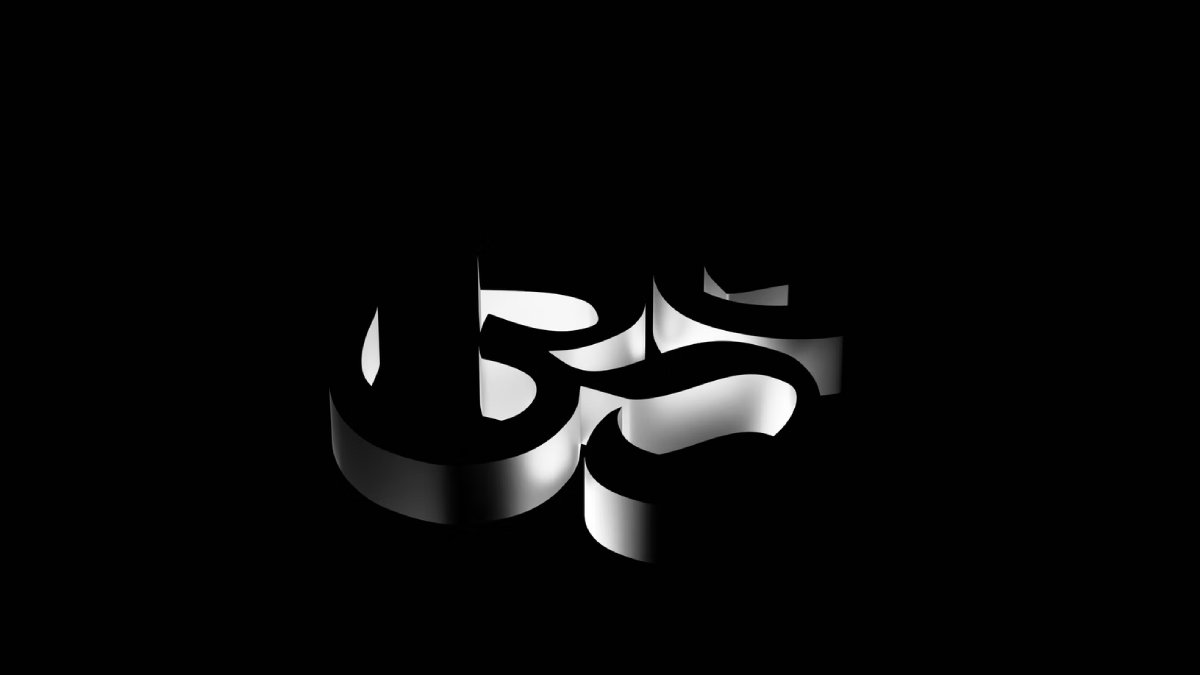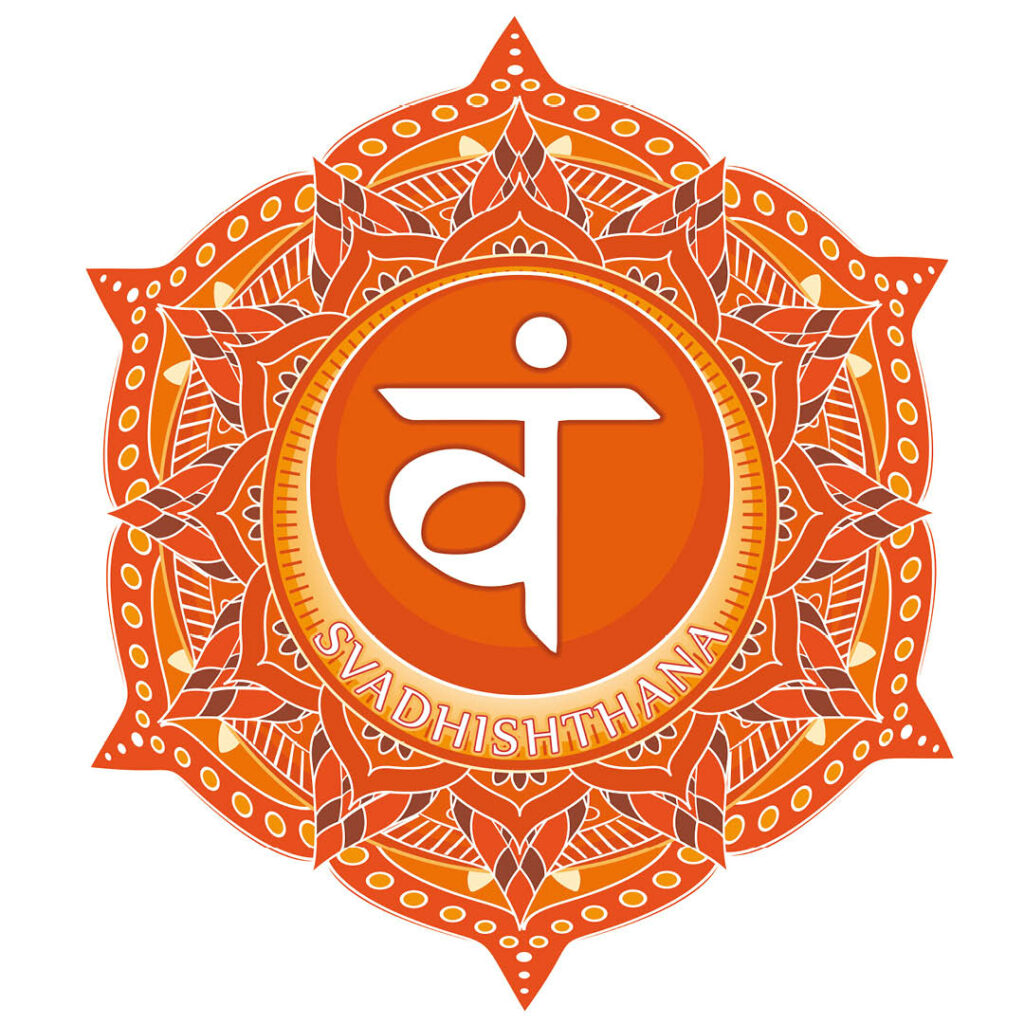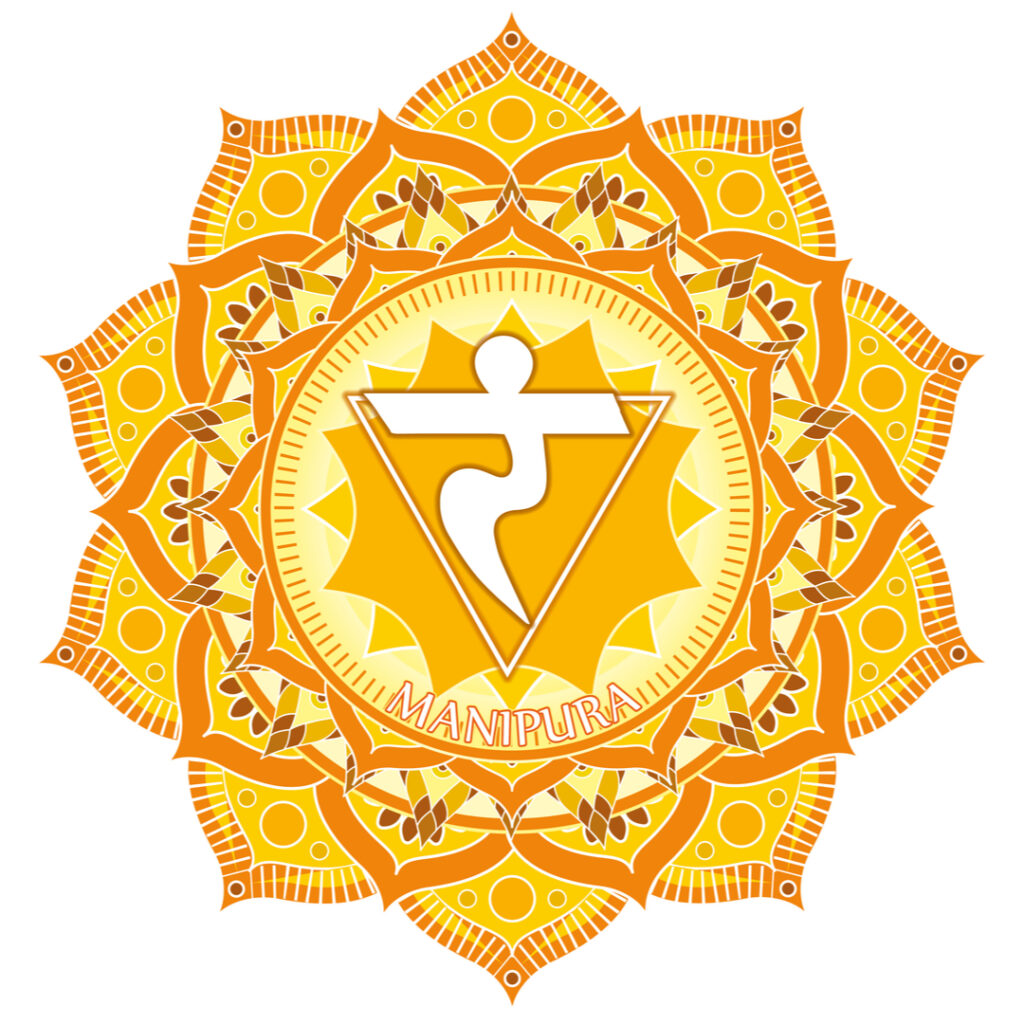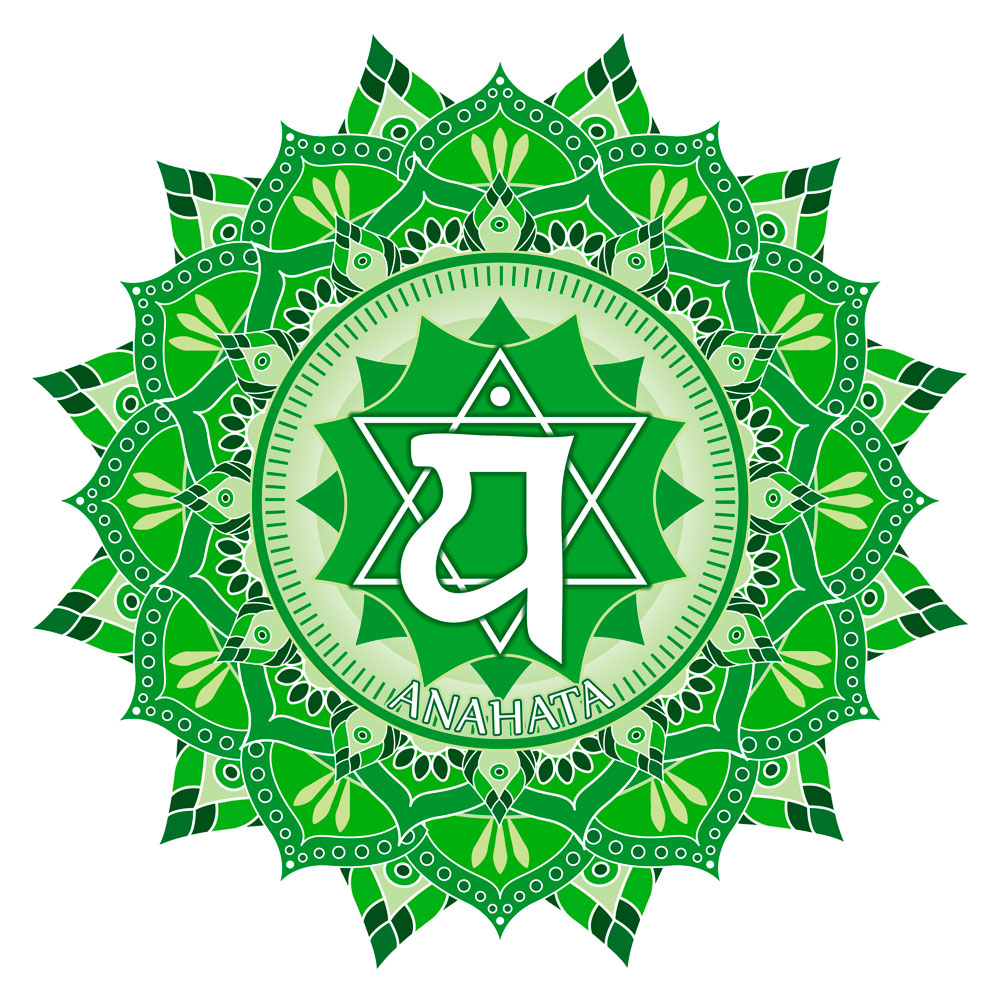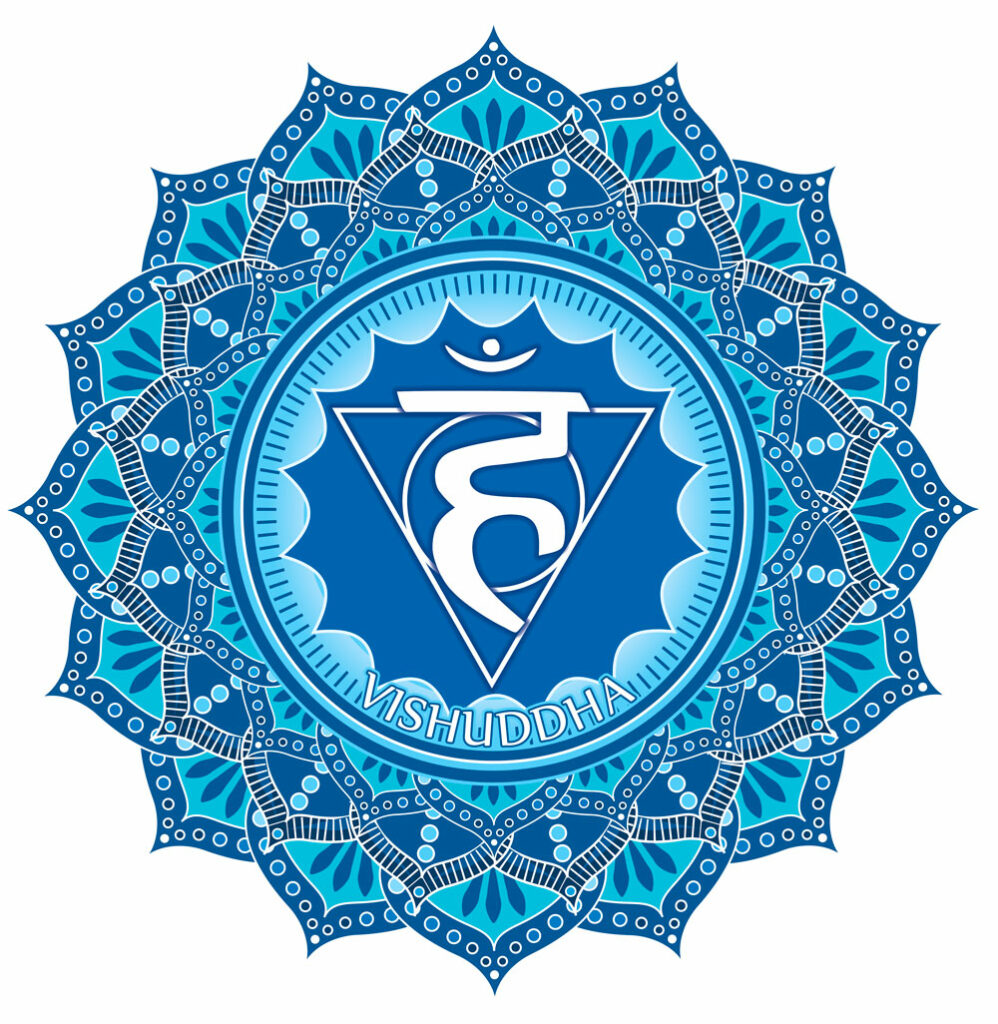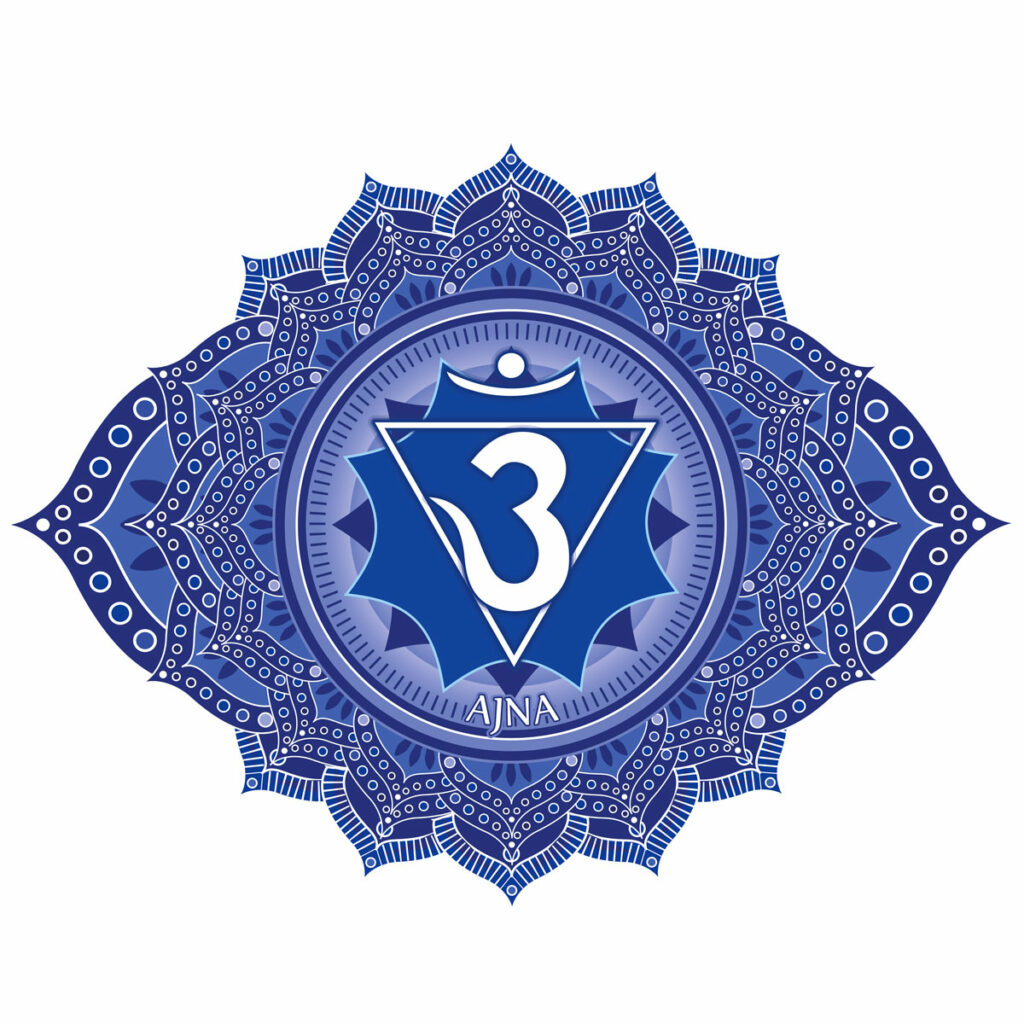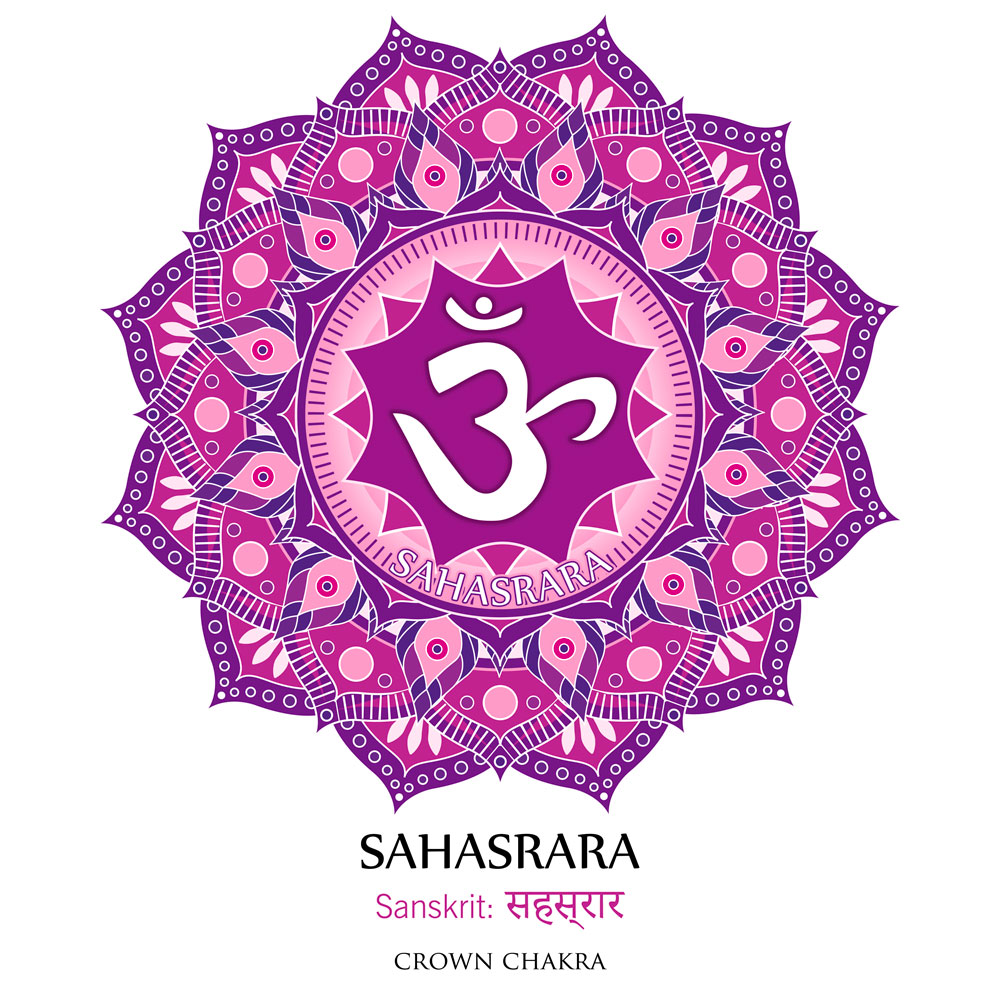Listen to this article:
Whether you get on your mat for physical exercise or as part of your spiritual journey, the world of yoga is filled with symbolic representations of yogic philosophies. These yoga symbols and drawings have been used for thousands of years to aid practitioners connect more deeply to their spiritual practice.
But sometimes the spiritual side of yoga can feel a little “woo woo” or inaccessible to the average person. If you’ve felt confused about the actual meaning of different yoga symbols, you’re not alone.
Many yoga symbols have a range of unique interpretations in different cultures and yoga practices. Ancient yogic tradition utilized diverse manifestations of yoga symbols such as the om symbol, the lotus flower, the hamsa hand, and specific drawings correlated with each chakra.
Whether you find them on yoga clothing, props, walls, tattoos, artwork, or other physical manifestations, understanding these spiritual symbols can help deepen your practice and add some grounding reminders to your daily life.
Here’s an introduction to the 16 common yoga symbols and what they mean, in plain language.
Contents
Om Symbol
Perhaps the most infamous of meditation and yoga symbols, the aum or om symbol represents the sound of the universe. It is thought to have been the first primordial sound that was made when the universe was created.
Om has cross-cultural meanings that transcend any specific religion or part of the world, however, its origins are rooted in the ancient holy language of Sanskrit. You might also recognize the different Sanskrit names of yoga poses like Chaturanga (four-limbed staff poses) or Uttanasana (forward fold).
When chanting om during a meditation class, you are connecting to a cosmic vibration that can help you feel more grounded, blissful, and clear. Chanting om is also associated with aligning the chakras and opening the third eye.
The “3-shape” of this yoga symbol has multiple meanings as a sound and a visual. In essence, it symbolizes three distinct states of mind. When spoken, the word “aum” also has three distinct parts with important symbolic meanings that coincide with the drawing itself.
- A “ahh”: The waking state is a metaphor for the universal creation and our peacefulness of existing. It is represented by the big bottom curve of the om symbol. This is the most recognizable state of consciousness where we experience life via our senses.
- U “ooh”: The dream state reminds us of our spiritual experience beyond the physical realm. It is represented by the middle curve between the waking and deep sleep state. This is where the subconscious can come through.
- M “mmm”: The deep sleep state, or unconscious state, is represented by the top curve of the om or aum symbol. This signifies surpassing consciousness into a spiritual realm where everything in the universe is connected.
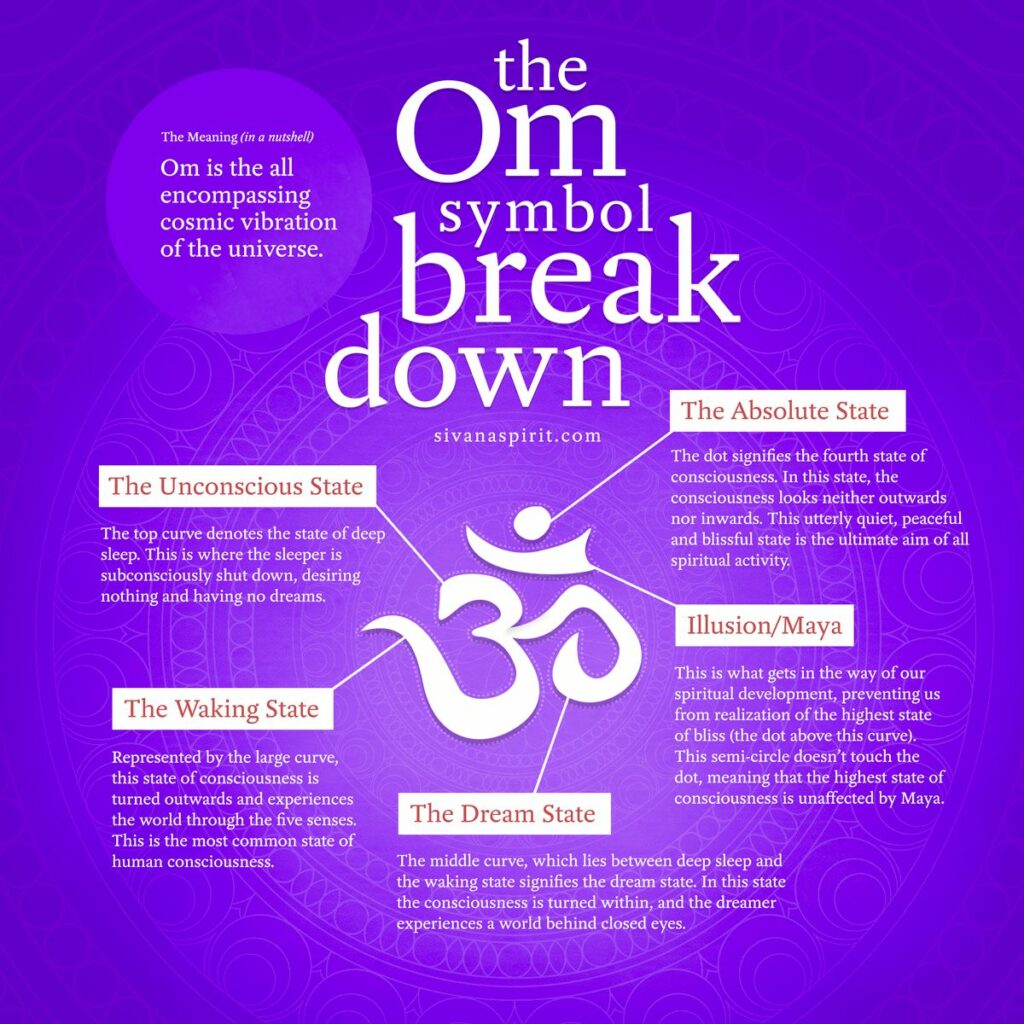
Is it okay to wear the om symbol?
It is common to find the om or aum symbol displayed on clothing, art, tattoos, and yoga accessories. This cross-cultural visual is perfectly fine to wear as a means of expression, as long as it is done so in a respectful way. Wearing the om symbol can help remind you to find the divine parts of the universe in everyday life.
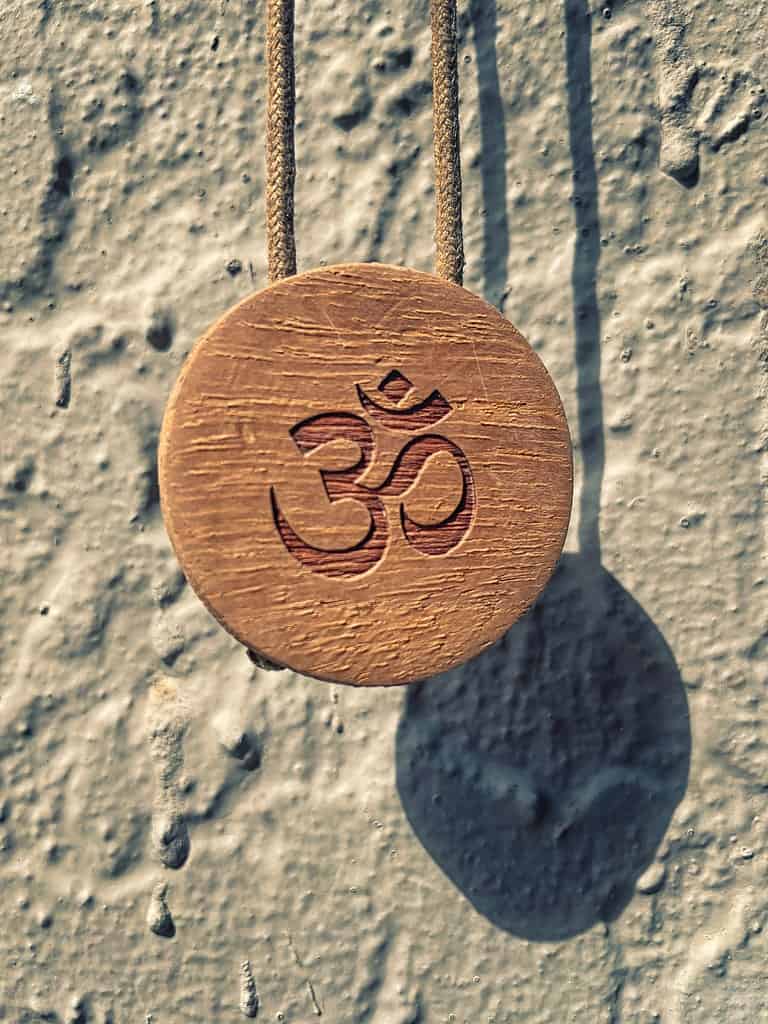
Hamsa Symbol
With roots in Middle Eastern and North African spirituality, the hamsa symbol has spiritual meanings in Buddhism, Muslim, Jewish, and Hindu cultures. However, it is not linked to any specific religion or spiritual belief system. The earliest evidence of the hamsa image has been found in ancient Mesopotamian tombs from as far back as 1500 BC.
When used as a talisman or piece of jewelry, it is thought to protect the wearer from evil or negative forces. Hamsa is most broadly seen as a symbol of luck and good fortune.
The number 5 is also significant to this yoga symbol. The name Hamsa has 5 letters and the emblem displays the 5 fingers of a hand. They can be interpreted to represent the 5 holy books of Judaism, the 5 human senses, the 5 holy mudras of Hinduism, or the 5 pillars of Islam.
Regardless of religious affiliation, the hamsa emblem has a universally positive association with peacefulness, success, harmony, and protection from evil or misfortune.

We love this hamsa and evil eye chakra bracelet made with lava stone that can be infused with your favorite essential oils.
Evil Eye Protection Symbol
With its striking turquoise and white centric circles on an indigo backdrop, the evil eye image is a recognizable but confusing yoga symbol. Found on amulets and jewelry, this symbol is found on its own or coupled with the hamsa hand. The hamsa evil eye combo signifies protection from negative forces.
The superstition surrounding the evil eye dates all the way back to ancient Greece and Rome. Over 3,000 years later, we still find this striking eye used in spiritual practices around the world. Many cultures have different stories for the evil eye, but the myth is largely the same: When cast upon someone else, the evil eye can cause misfortune, suffering, or even disaster for someone else.
In ancient Greece, the evil eye was specifically a threat to anyone who received more praise than they deserved. It was thought that the gods and goddesses would punish anyone who became too wrapped up in their pride by destroying them with the power of the evil eye.
Islamic culture shares the same superstitions around the evil eye’s ability to punish anyone with excessive praise and ego. Hindus are similarly very wary of the evil eye and associate its power with the malice of jealousy and excessive admiration.
Ironically, when worn as an amulet, the evil eye actually protects against all these negative forces. You can think of the evil eye metaphor as a curse, whereas the amulet dispels the curse. It is believed that the evil eye talisman “reflects” back the power of the evil eye and thus protects the wearer from its power.
The classic concentric blue evil eye design is found throughout the Middle East, however the evil eye can take on many eye-shaped forms. It is a reminder to remain humble in your yoga practice and your life at large. It is also a great way to protect your energy from negative forces like jealousy, manipulation, or greed.
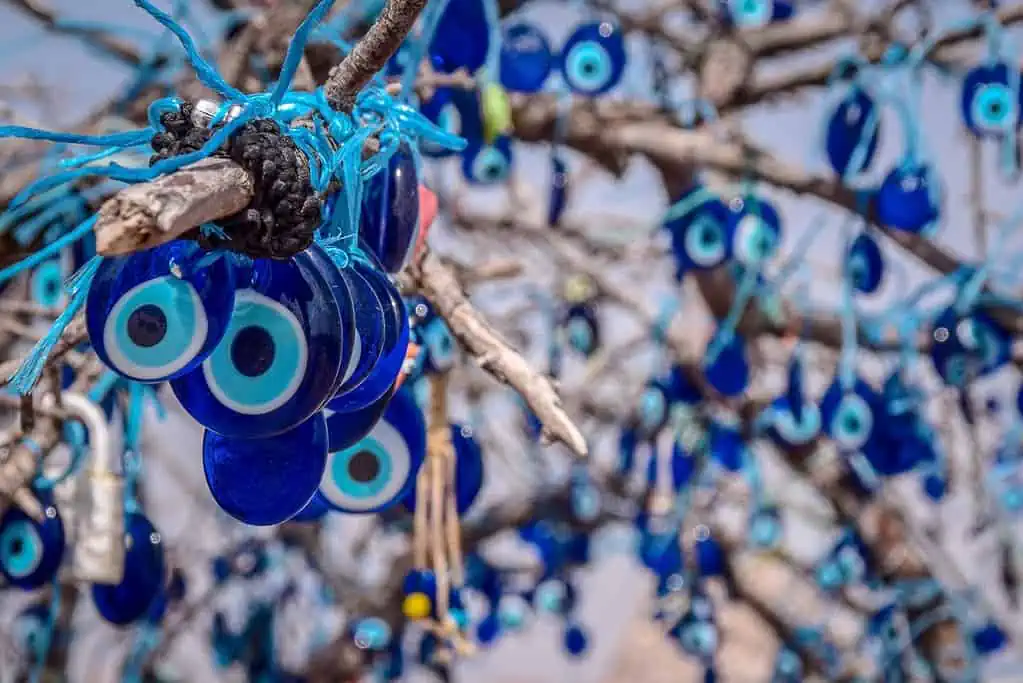
Chakra Symbols
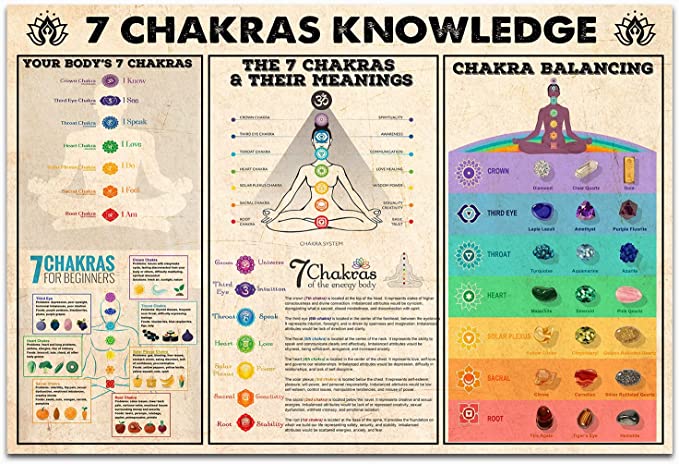
The seven chakras are the energy centers of the human body. Rooted in both science and spiritual practices, chakras were first mentioned in ancient Vedic texts in India over 3,000 years ago.
Chakra is a Sanskrit word that means “wheel”“. These wheels of energy hold different symbolic meanings that are associated with particular yoga poses, body parts, colors, mantras, elements, emotions, and aspects of life.
This poster provides an incredible visual for the walls of your home yoga room or yoga studio.
Understanding the meaning of each chakras symbol could be a huge breakthrough in your yoga journey, so let’s dig into each center individually.
Root Chakra (Muladhara)
The root chakra is the foundational energy for all emotional and physical states. It is the very first chakra that forms between the ages of 1 and 7 years old. Like the roots of a tree, this chakra is the very base of your existence and crucial for feeling grounded as you flow through the world.
A blocked root chakra can manifest physically as digestive issues, arthritis, or bladder ailments.
Emotionally, a blocked Muladhara may lead to financial insecurity, stress, a lack of self-confidence, or not feeling safe in your body.
Energetically, you may feel tired, lethargic, unproductive, or just “stuck” if this chakra is blocked.
When the energy of your root chakra is free-flowing, you are grounded in your identity or role in the world. You feel safe and secure.
Location: Base of the spinal column, near your tailbone
Associations: Survival, safety, stability, comfort, security, career, money, sense of belonging
Organs: Bladder, reproductive organics, vertebral column, hips, knees, legs, feet
Mantra: “I am” or “LAM”
Color: Red
Element: Earth
Stones: Hematite, black tourmaline, tiger’s eye, bloodstone
Foods: Root vegetables, tomatoes, pomegranates, strawberries, raspberries, apples
Yoga Poses: Child’s Pose (Balasana), Garland Pose (Malasana), Forward Fold (Uttanasana), Mountain Pose (Tadasana), Warrior II (Virabhadrasana II)
Essential Oils: Rosewood, rosemary, cedar, sandalwood, ginger
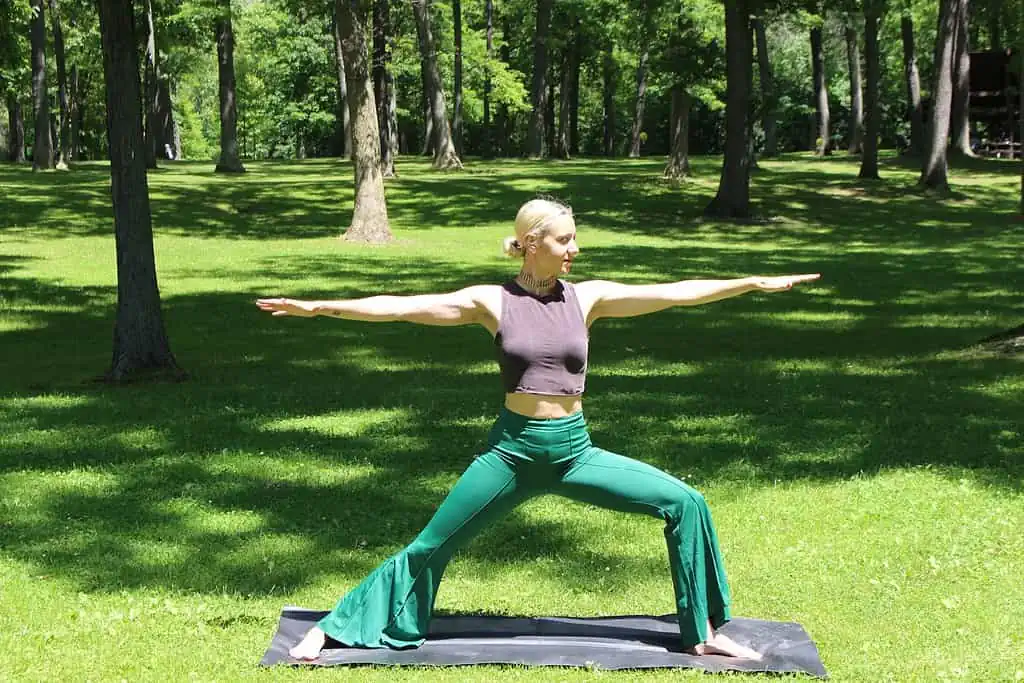
Sacral Chakra (Svadhisthana)
The sacral chakra is all about emotional and passionate identity. It governs how we relate to our feelings as well as those of other people.
The second center in the body, the sacral chakra develops between ages 8 and 14. The Sanskrit term Svadhisthana translates to “where your being is established” or “the dwelling place of self”.
A blocked sacral chakra can feel like an overall lack of control. Physically, it may reveal itself as reproductive issues, physical dysfunction, menstrual pain, lower back pain, or stomach and kidney disorders.
Emotionally, blocked sacral energy often leads to co-dependency, emotional overwhelm, obsession with obscene fantasies, or a complete lack of interest in relationships.
Energetically, this chakra is very linked to creative energy, therefore you may feel uninspired or out of touch with your artistic expressions when this chakra is blocked.
Unblocking and freeing the energy of the sacral chakra can feel more fluid like water. You become more able to flow through creative, passionate, and emotional experiences with versatility and freedom. The sacral realm is all about pleasure and unblocking this chakra can balance your ability to enjoy pleasure in your life.
Location: Lower abdomen (below the navel, including the genitals, womb, and lower pelvis)
Associations: Creativity, passion, playfulness, relationships, emotion, pleasure
Organs: Genitalia, bowels, kidneys
Mantra: “I feel” or “VAM”
Color: Orange
Element: Water
Stones: Amber, citrine, jasper, carnelian
Foods: Carrots, oranges, pumpkin, mango, papaya
Yoga Poses: Goddess pose (Utkata Konasana), Reverse Warrior (Viparita Virabhadrasana), Seated Forward Bend (Paschimottanasana), Reclined Bound Angle Pose (Supta Baddha Konasana)
Essential Oils: Clary sage, orange, sandalwood, bergamot, geranium
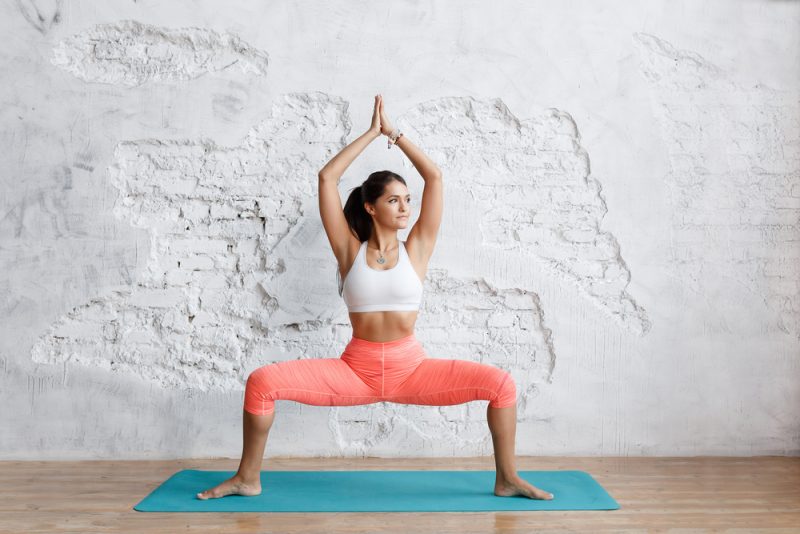
Solar Plexus Chakra (Manipura)
The third chakra is the naval solar plexus chakra. It develops around the ages of 15 to 21 years old and is intricately linked to confidence, self-worth, and self-esteem.
A blocked solar plexus chakra can lead to physical struggles like overeating, weight gain in the stomach area, IBS, diabetes, and fatigue.
Emotionally, a blocked navel chakra can lead to disempowerment, insecurity, low self-confidence, self-doubt, indecisiveness, and problems with anger or bullying.
Energetically, the solar plexus governs our feeling of control. When it’s blocked, you may feel out of control of yourself and your emotions, or even a desire to control other people.
When the solar plexus energy is open and able to flow freely, a person radiates confidence, motivation, purpose, and self-responsibility.
Location: Upper abdomen and core, from navel to lower breast bone
Associations: Confidence, self-esteem, control
Organs: Stomach, digestive organs
Mantra: “I do” or “RAM”
Color: Yellow
Element: Fire
Stones: Amber, yellow jasper, agate, lemon quartz
Foods: Bananas, pineapple, corn, yellow curry, lemons
Yoga Poses: Boat pose (Navasana), Bow Pose (Dhanurasana), Cobra Pose (Bhujangasana), Reverse Plank Pose (Purvottanasana)
Essential Oils: Lemongrass, saffron, musk, cinnamon
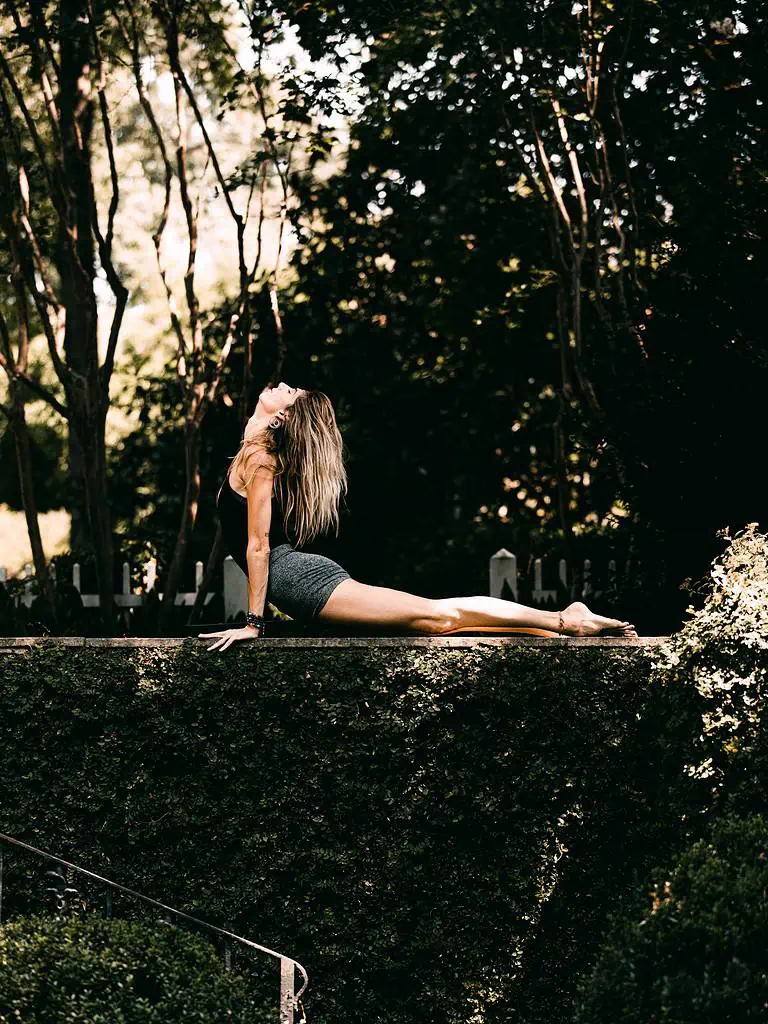
Heart Chakra (Anahata)
The center of our being, the heart chakra is an important yoga symbol to link the lower chakras (material or physical aspects) with upper chakras (the spiritual self). This fourth chakra is thought to develop between ages 21 and 28 years old.
In Sanskrit, anahata means “unhurt” or “unbeaten”. It is the core source of our love, empathy, compassion, and joy for ourselves and others.
The deeper meaning behind the heart chakra is feeling worthy to give love and receive it from others. A blocked heart chakra can feel like physical chest pain, low energy,
Emotionally, blockages in Anahata may feel like an inability to forgive other people, feeling detached or emotionally numb, or feeling unable to trust and open up with others. It can even reveal itself as hatred, revenge, or pushing people away.
Energetically, heart chakra blockages can be exhausting and stressful. Deep emotional healing is often necessary to unblock this region of the body.
We focus on the heart center so much during yoga because it is the source of love and compassion. Ending your yoga practice with your hands at heart center signifies your openness to universal love and peacefulness.
Location: Heart, center of the chest
Associations: Love, compassion, joy, inner peace
Organs: Heart
Mantra: “I love” or “YAM”
Color: Green
Element: Air
Stones: Rose quartz, rhodochrosite, aventurine, emerald
Foods: Avocado, kiwi, zucchini, cucumber, parsley, broccoli, kale, lime, spinach
Yoga Poses: Heart-openers like Bridge Pose (Setu Bandha Sarvangasana), Cat/Cow (Marjayasana/Bitilasna), Camel Pose (Ustrasana), Upward Facing Dog (Urdhva Mukha Svanasana)
Essential Oils: Cypress, jasmine, lavender, geranium, rose

Throat Chakra (Vishuddha)
The fifth primary chakra is located in the throat and holds the power of communication. This yoga symbol represents our ability to be quiet as well as our vocal force for practicing meditation and chanting. The throat chakra is all about self-expression.
When this chakra is blocked, physical issues may manifest in the throat region, such as neck pain, losing your voice, sore throat, dental issues, thyroid imbalance, and problems with hearing.
Emotionally, a blocked throat chakra leads to feeling unable to clearly express yourself. You may feel nervous to talk or unable to speak your truth. It can also block creativity and lead to feelings of insecurity around artistic expression.
Energetically, an unbalanced throat chakra is linked to feeling shy or isolated, perhaps even social anxiety.
When it’s fully functioning in all its glory, the throat chakra yields open expression and a feeling of speaking your truth to the world. Often it can empower singers, public speakers, podcasters, and other vocal professionals.
Location: Throat
Associations: Communication, truth, self-expression, speaking
Organs: Throat, thyroid glands, vocal box, lungs
Mantra: “I speak” or “HAM”
Color: Blue
Element: Music or sound
Stones: Aquamarine, turquoise, lapis lazuli, blue apatite
Foods: Coconut water, herbal teas, honey, plums, sage, spirulina, kelp
Yoga Poses: Neck stretches and neck rolls, Shoulder Stand (Salamba Sarvangasana), Plow Pose (Halasana), Fish Pose (Matsyasana)
Essential Oils: Basil, peppermint, bergamot
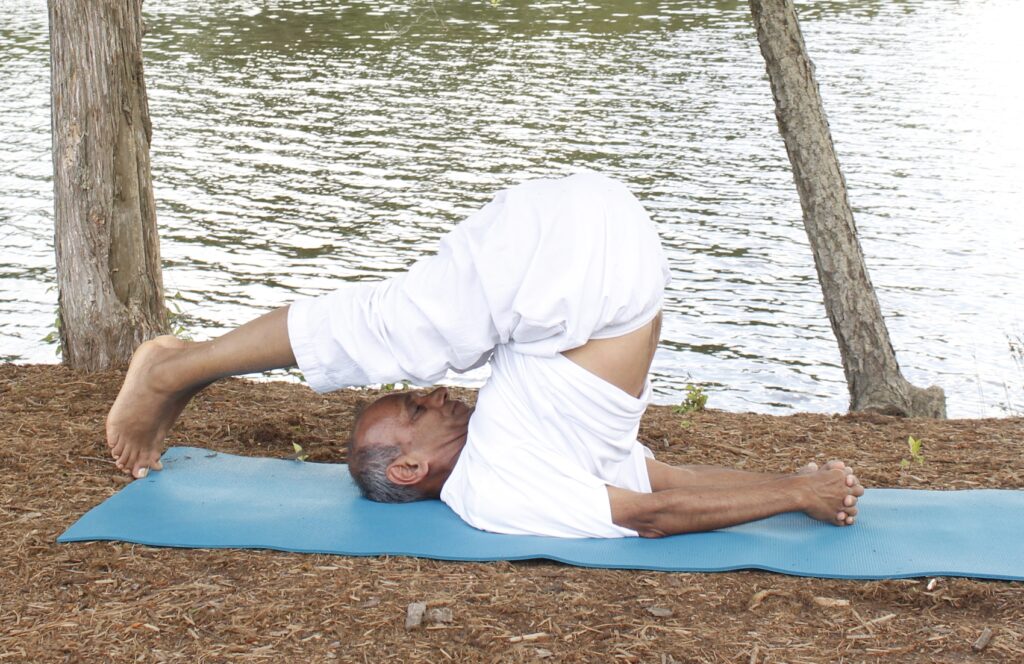
Third-Eye Chakra (Ajna)
Almost every yoga or meditation class mentions the third eye as a point of focus during your practice. The third eye chakra is called Ajna and it controls our intuition and ability to look at the bigger picture beyond the present moment. This chakra develops between ages 36 and 42 years old.
This chakra is one of the most common spiritual yoga symbols because of its association with opening the soul to things beyond the surface level. When it is open, Ajna yields a free flow of spiritual wisdom, insights, and a greater positive vision for one’s life or the world.
When blocked, this chakra may lead to physical issues with eyesight, migraines, sciatica, sinus problems, and a lack of focus. Emotionally, an unbalanced third eye chakra can feel like you’re “stuck in the grind” or unable to see a bigger picture for your life.
Energetically, people with blocked third eyes tend to reject spirituality and may only practice yoga for the fitness benefits. They may regularly engage in fantasies or dreams that they don’t plan to execute as part of a greater vision for their life.
Location: Forehead, between the eyebrows
Associations: Imagination, wisdom, spirituality, intuition, perception, sight, inspiration
Organs: Pineal gland
Mantra: “I see” or “SHAM”
Color: Purple or dark blue
Element: Light
Stones: Amethyst, black obsidian, citrin, celestite, fluorite, labradorite
Foods: Blueberries, cacao, purple cabbage, eggplant, grapes
Yoga Poses: Eagle Pose (Garudasana), Dolphin Pose(Catur Svanasana), Child’s Pose (Balasana), Forearm Stand (Phalaksana II), Downward Facing Dog (Adho Mukha Svanasana)
Essential Oils: Patchouli, citrus, frankincense, juniper, marjoram
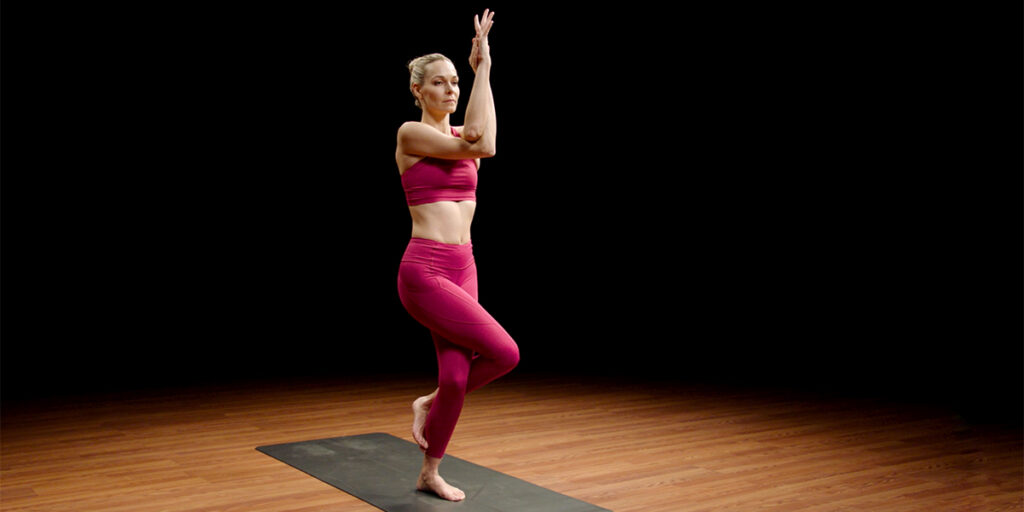
Crown Chakra (Sahasrara)
The crown chakra is the highest chakra. All the chakras must be balanced to access this state of grace. It represents full spiritual integration and enlightenment. Sahasrara is the highest level of divine consciousness known to mankind.
Yogic tradition says that this chakra develops between ages 43 and 49 years old. It is associated with a deep spiritual connection to everything in the universe.
A blocked crown chakra is linked to materialism, fear, apathy, a broken spirit, or problems with memory, learning, and spirituality. Though most people never fully open the crown chakra, its full manifestation is a deep knowing of spiritual truths. The yoga asana headstand is particularly linked to the crown chakra.
Location: Very top center of the head
Associations: Knowing, connection to spirit and God, unity, wisdom, open mind, spiritual awakening
Organs: Spinal chord and brain
Mantra: Silence, “I understand” or “OM”
Color: White or violet
Element: Divine Consciousness
Stones: Clear Quartz
Foods: Water, tea, sunlight, fasting
Yoga Poses: Headstand (Sirsasana), Rabbit Pose (Sasangasana), Lotus Pose (Padmasana)
Essential Oils: Frankincense, myrrh, lavender

Mandala Symbol
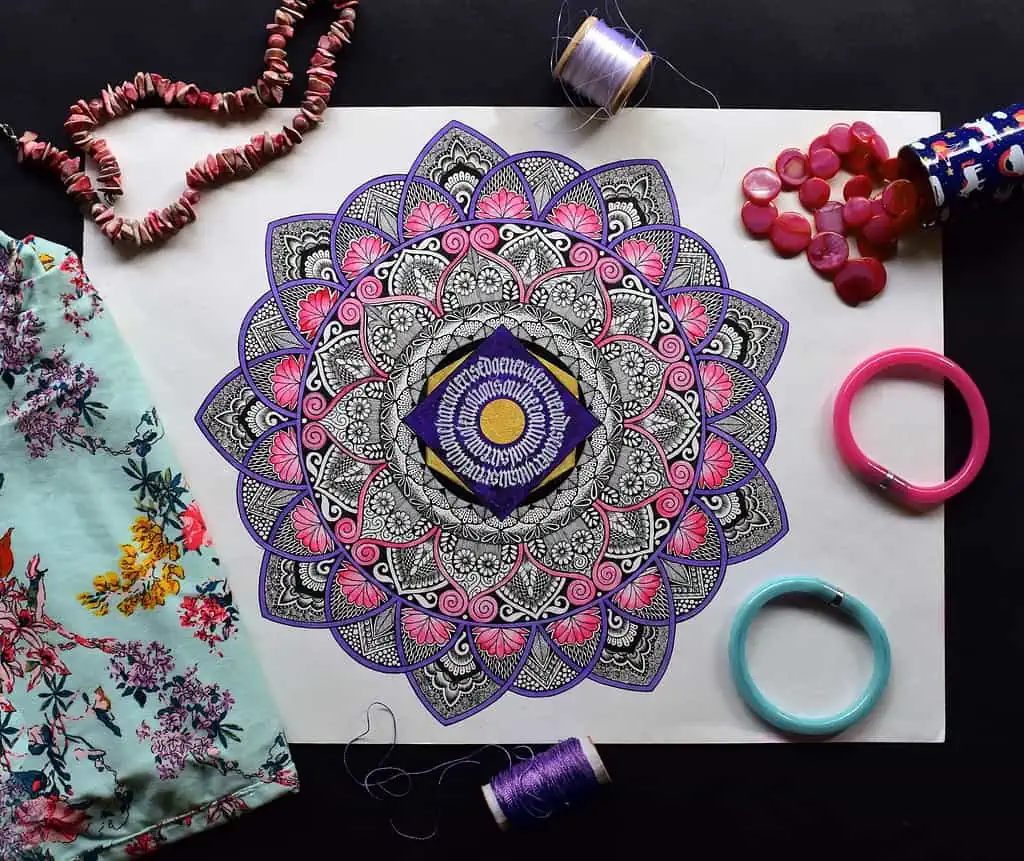
The geometric mandala symbol is found on yoga mats, the walls of yoga studios, urban murals, patterned clothing, and even adult coloring books. They entice your eyes with an array of shapes that symbolize the harmony between mind, body, and spirit.
In Sanskrit, mandala means “circle” and is often used as a metaphor for the universe. The vibrant colors, shapes, and textures signify the spiritual journey of the human soul from the inner core through many layers to the outer lines.
Mandalas also symbolize the impermanence of life on Earth. Tibetan Buddhist monks make exquisitely detailed sand mandalas only to wipe them away once complete.
Specific colors in a mandala often come with certain meanings in yogic traditions:
- Red: Vitality, strength, passion
- Orange: Self-awareness, intuition, transformation
- Yellow: Humility, laughter, joy, learning
- Green: Nature, freshness, improving mental and physical health
- Blue: Infinity, life, inner peace
- Purple: Spirituality found in everything
- Black: Darkness, mystery, individuality
- White: Openness, spirituality, purity
Mala Beads

Mala beads are meditation necklaces used in Buddhist and Hindu culture. Similar to the Catholic rosary, these garlands are aids for moving into a more spiritual state of consciousness.
They typically contain 108 beads and one larger bead called the Guru bead. This larger Guru bead represents a spiritual guide and is used as a marker to begin and end an enlightenment meditation.
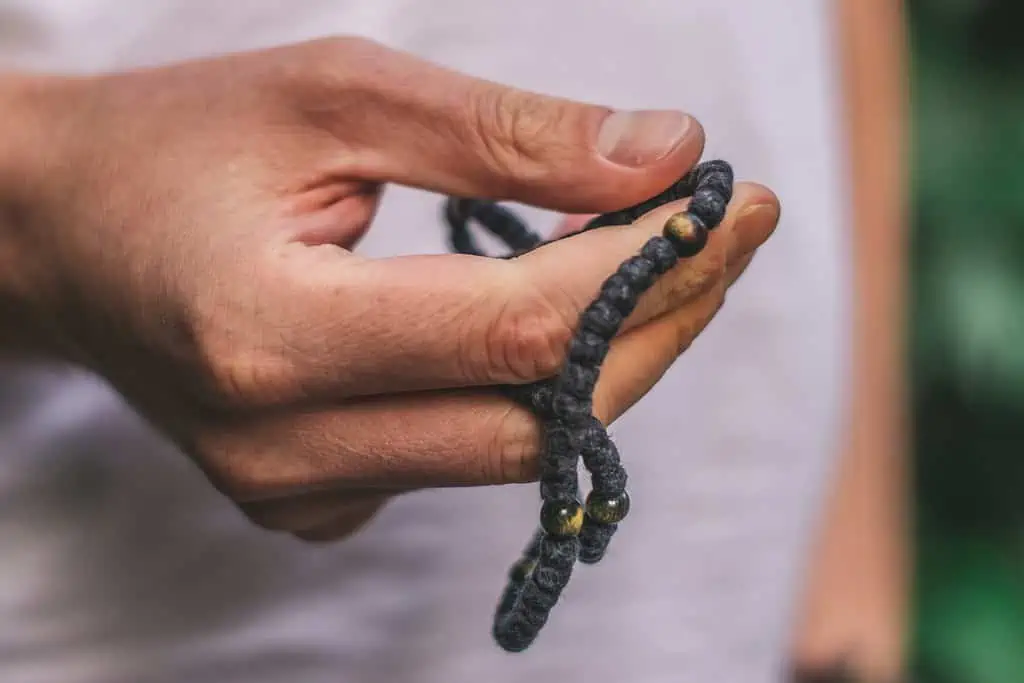
Traditionally, the beads help you track how many times you repeat a mantra or prayer. You can move your finger from one bead to another as you close your eyes and meditate. More than just a necklace, mala beads are spiritual symbols for connecting with the sacred.
Mala does not need to be used as part of a rigid belief system. In fact, they can be used by any practitioner to bring more focus and awareness to chanting or meditation. However, it’s not recommended to wear mala beads solely for fashion.
Lotus Flower Symbol
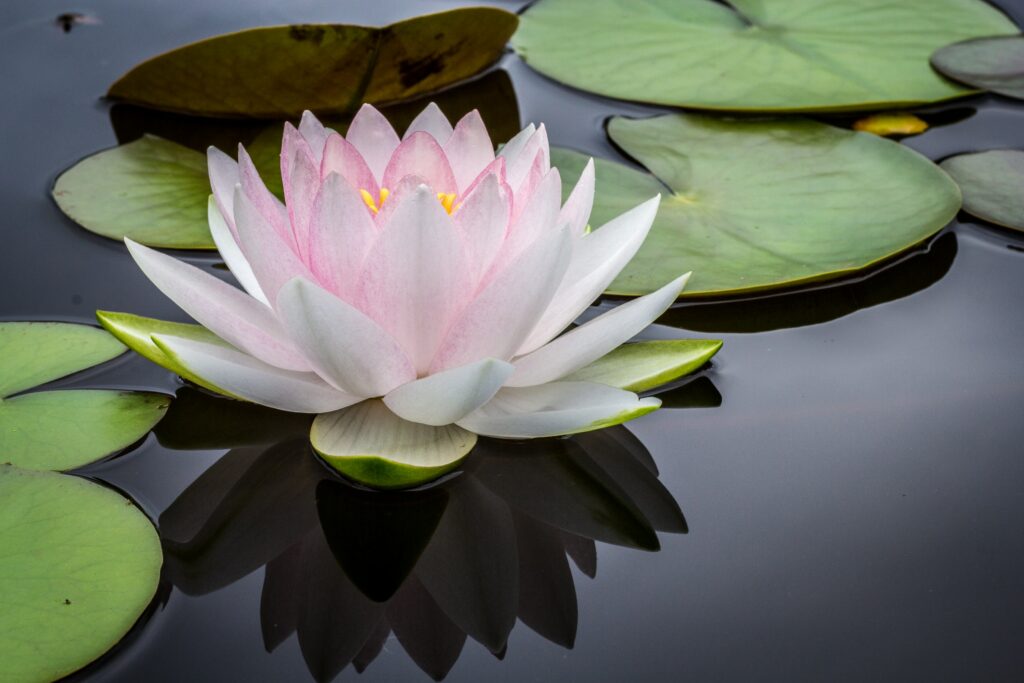
In Greek mythology, the lotus flower is often representative of temptation. This symbolism comes from Homer’s Odyssey wherein people who fell victim to the temptation of eating lotus would forget what happened.
However, as a yoga symbol, the lotus flower holds an entirely different meaning. They are associated with positivity, power, and possibility.
In Eastern philosophy, lotus flowers are metaphors for the human spiritual journey. Lotus flowers grow from the muck and slime of even the dirtiest water, somehow remaining pure and clean as they bloom upward.
This growth from darkness represents hope for individual people to overcome the darkness of the world and grow into spiritual beings. Nobody is doomed to stay where they began.
An open lotus flower is a symbol of beauty, fertility, prosperity, and eternity. It is often used as an offering to Hindu gods. It can also represent struggling through the mental and physical challenges of yoga to flower into the highest version of yourself.
Like mandalas, the lotus flower is often portrayed in a variety of colors with different meanings:
- The blue lotus represents wisdom, intuition, and sound judgment
- A pink lotus flower is the divine symbol of the Buddha
- A red lotus flower conveys matters of love and the heart
- A purple lotus represents mysticism, spirituality, and the Noble Eightfold Path of Buddhism
- A white lotus represents purity
The Number 108
Another cross-cultural motif, 108 is one of the most sacred spiritual yoga symbols that is revered in religions around the world. The number 108 signifies the wholeness and unity of all of existence. It also refers to spiritual completion.
There are many cultures and belief systems that reference the number 108:
In numerology, the number 108 is an auspicious sign that you’re about to attain a goal or achievement you’ve been working towards.
The 1 stands for higher spiritual truth, the 0 stands for emptiness and completeness, and the 8 represents infinity. Adding these numbers together also represents the number 9, which is known to be associated with altruism and humanitarianism.
The Fibonacci sequence, developed by mathematician Leonardo Fibonacci in 1170, is known as “nature’s secret code” and contains numerous references to the number 108.
Hindu mala beads contain 108 beads and Japanese Buddhist temples chime their bells 108 times to usher in a new year. Tibetans have 108 sacred books and Stonehenge has a diameter of 108 feet.
In yoga, sun salutations were originally developed by ancient yogis to be completed in 9 cycles of the 12 asanas (9 x 12 = 108).
Needless to say, the sacred number 108 is woven throughout yogic philosophy as a symbol of wholeness and completeness.
Buddha

You can’t talk about yoga symbols without mentioning the Buddha. From India to Japan to the West, the face of the Buddha is globally recognized as a symbol of peace. A popular symbol for spirituality in general, the image of the Buddha has its origins in Tibetan and Indian Buddhist practices.
In its physical form, you can commonly find the Buddha portrayed as a seated meditating figure with an oval-shaped hat or crown.
Historically, Buddha was an actual person. Siddhattha Gotama Buddha was the ancient spiritual teacher and mystic credited with founding the Buddhist religion. His aim was to liberate life from suffering through The word “Buddha” itself, which means “enlightenment”.
Unlike other religious figures like Jesus Christ or Muhammad, technically all living beings can become a Buddha by attaining a state of enlightenment and seeking to free sentient beings from suffering.
The image of Buddha in temples, yoga studios, and on clothing or accessories should be used as reminders of the core Buddhist teachings:
- The Three Universal Truths: Annica (everything is impermanent), dukkha (impermance leads to suffering and life is imperfect), and anatta (no-self or the absence of ego)
- The Four Noble Truths: The truth of suffering, the truth of the cause of suffering, the truth of the end of suffering, and the truth of the path that leads to the end of suffering
- The Noble Eightfold Path: Right understanding, right thought, right speech, right action, right livelihood, right effort, right mindfulness, and right concentration
Statues and emblems of Buddha represent peacefulness, wakefulness, and morality. They are often used at the doors of homes or temples to protect you from harm and evoke mindfulness in your daily life.
Buddhist statues should be kept clean and never allowed to accumulate dust. Some cultures make offerings to the Buddha statue on a daily basis.
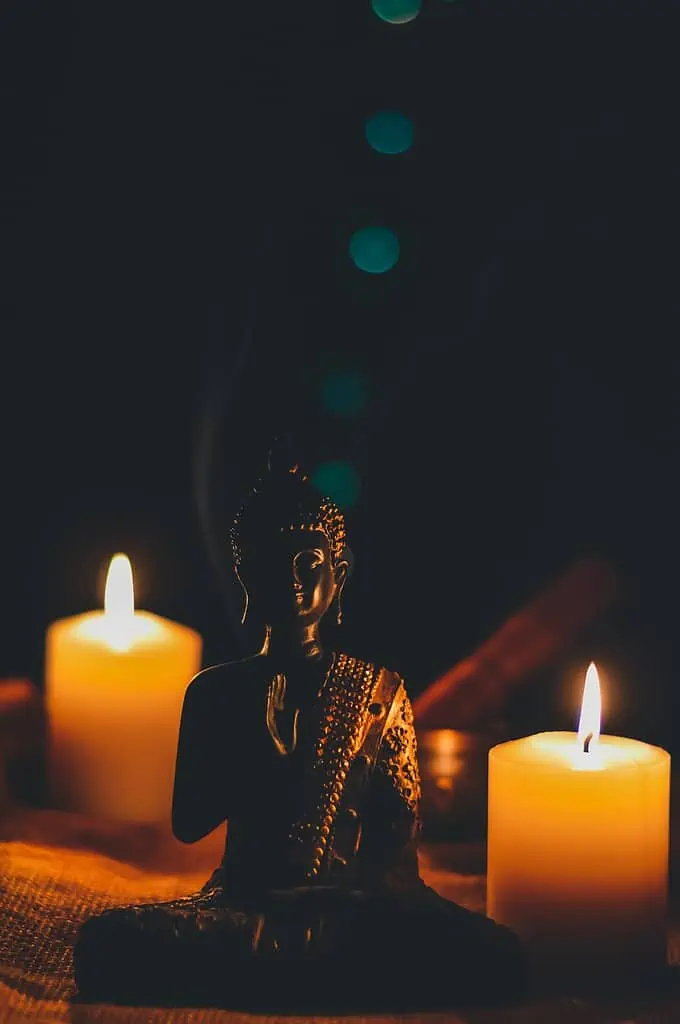
Is it okay for me to wear a Buddha necklace?
There are differing opinions about whether or not the Buddha should be depicted on clothing, jewelry, or tattoos. The Buddha is not considered a god, nor is his image solely reserved for those who practice the Buddhist religion.
Symbolically, the Buddha represents mindfulness and peacefulness, so many spiritual leaders agree that it is OK to wear images of the Buddha as long as they are respected and used as a reminder of the Buddha’s holy teachings.
Ganesh
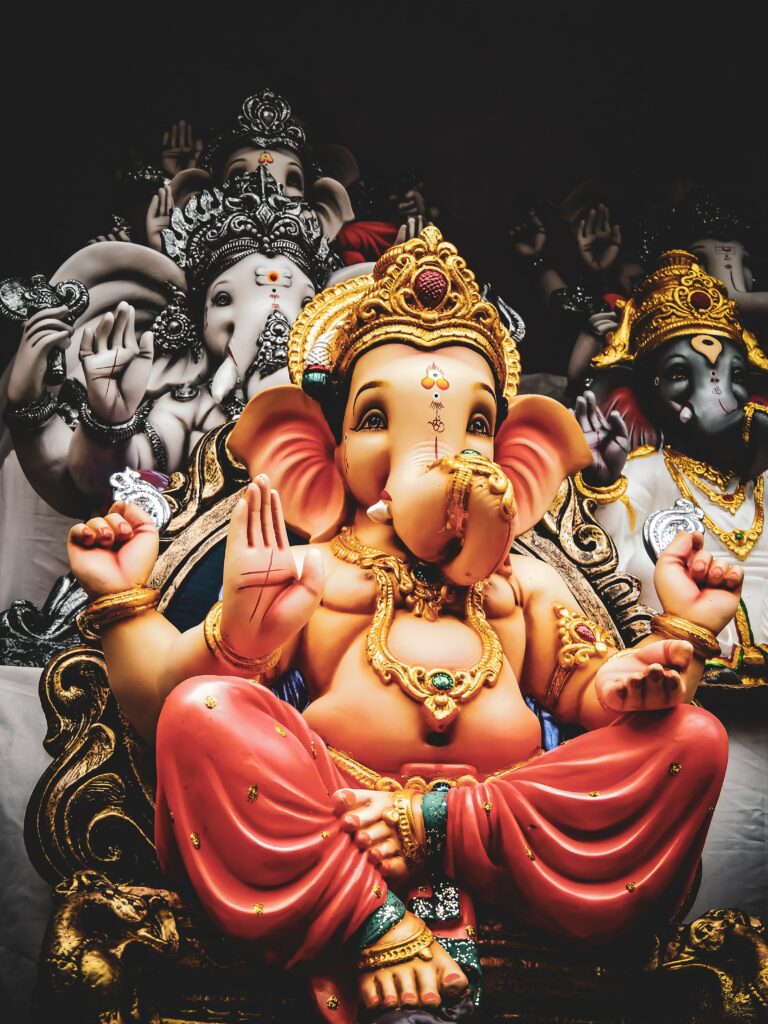
If you’ve ever seen the depiction of an elephant head in yoga classes as a statue or tapestry, you may be familiar with Ganesh without even knowing it. This yoga symbol is a Hindu god associated with the root chakra. Ganesh is the Lord of People, the Lord of Beginnings, and the Lord of Good Fortune. He represents success, prosperity, and the removal of obstacles of all kinds.
The elephant depiction of this god is important to the deeper meaning as a yoga symbol:
- Elephants are known for being wise and loyal
- The large head encompasses knowledge and embraces “thinking big” in our visions of life and the world
- Small eyes represent diligence, focus, and appreciation of the little things
- Large ears show that he can hear the needs of his people, reminding us to listen more
- The small mouth is a reminder to speak less
- A single tusk is symbolic for focusing on the good and letting go of the negative (the other tusk)
FAQs
How to use yoga symbols?
Yoga symbols can be used as part of your practice in a variety of ways. If there are specific yoga symbols that speak to you, you may seek them out on your mat, clothes, jewelry, or wall hangings. Some yoga symbols can also be incorporated into your rituals, for example, mala beads in meditation or specific chakra symbols for unblocking work.
What are the 3 symbols in yoga?
The om or aum symbol is representative of the primordial sound of the universe. It symbolizes the three distinct states of consciousness: the waking state, the dream state, and the deep unconscious state.


